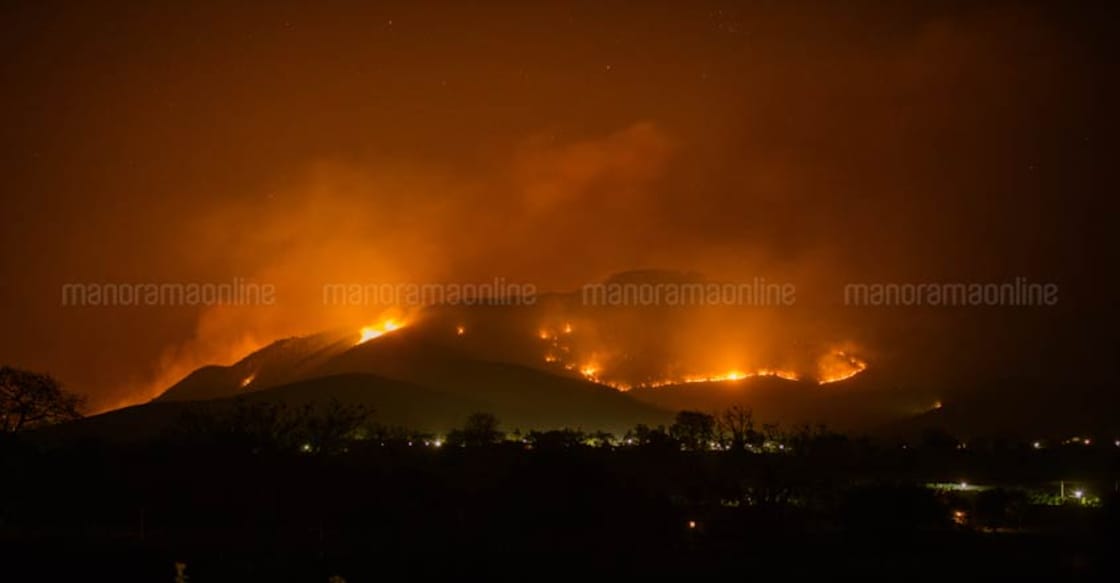The fascinating science of forest fires: Survival tips and preventive measures

Mail This Article
There has been an alarming increase in the number of fires recently. Ranging from forest fires to those occurring in parking lots, fire has caused unexpected damage to human lives, property and the environment. The tragic deaths of eleven young people in a forest fire in Bodhimettu, Tamil Nadu caught public attention a year ago. Dying in a forest fire is certainly not on anyone’s list of probable causes of death.
Fire can be fast, furious, devastating and unpredictable. It is important to note is that when disasters strike, what frequently makes a difference is prior knowledge and training in survival skills.
The objective of this article is to discuss the phenomenon of forest fires, along with specific preventive and survival tactics. The topic of home and office fires was covered in my earlier article:
Read: Everyday Health | Fire safety: what to do, what not to do
Fire requires three elements: oxygen, heat source and fuel, also called the fire triangle. Cutting off any one or more of these is essential to stop the fire.
How to escape from a forest fire: 7 survival tips

1. A forest fire can travel faster than man can run. Trying to outrun the fire therefore might not always work. Speeds over 20 kmph can occur, especially with favourable winds. Our survival depends heavily on the earliest detection of danger—and what we do afterwards.
The first sign of forest fire might be ashes falling from the sky, blown about by the wind. The smell of smoke and a frightening noise are other signals that a fire is coming at us. Learning to recognise it early can mean the difference between life and death.

2. Fire travels faster uphill as hot air rises. The speed doubles for every 10 degrees of upward slope. It is therefore better to run to a lower slope on the other side of the hill rather than try to climb to the top and perish. Besides, running uphill drains our energy, leading to collapse.
3. If the fire is advancing towards us, the safe option is to run towards a pond or stream nearby and stay in it till the fire passes. A depressed area or pit is the next best option.

4. Fire spreads to areas where there is vegetation. Taking shelter among bushes and trees is therefore a bad idea. It is better to find barren ground or a flat rocky surface to escape from being burnt.
5. If a road or stream is found, crossing to the other side will help create a barrier between ourselves and the fire.
6. Fire spreads in the direction of the wind. A change in wind direction and speed can suddenly change the direction, speed, pattern and destructive power of the fire. In addition, a big fire can generate its own wind due to massive movement of heated air. It is therefore important to keep track of the wind’s direction when there is fire in the vicinity.
For instance, when a fire is seen far behind us, moving ‘upwind’ or against the direction of the wind will help us increase the safety gap between ourselves and the fire.

Wind can ignite ‘spot fires’ ahead of the main fire. Burning twigs and leaves travel in the wind and start other fires, which might surprise those who are trying to run away from the original fire.
7. Smoke is as dangerous as fire. In addition to injury from burns caused by flames, deaths from forest fires also occur from asphyxiation due to lack of oxygen, and from inhaling toxic gases present in the smoke. Carbon monoxide gas, generated by incomplete combustion of fuel, irreversibly binds haemoglobin, thus destroying the ability of our red blood cells to carry oxygen. In addition, disorientation induced by carbon monoxide makes escape difficult.
Smoke always rises to the top. If caught in thick smoke, the best option is to crouch on the ground where visibility is better and there is greater chance of breathing clean air. Covering our nostrils with a wet cloth helps reduce the severity of smoke inhalation.
8. If escape by running away from the fire is not possible, a rather surprising option is to run towards the fire. After identifying its weakest leading edge, it might be possible to cross quickly to the other side. The objective is to find shelter in previously burnt areas, where the fire has already died down. The logic applicable here is that fire doesn’t visit the same place twice.
While attempting this, heat injury can be minimised by throwing some green leafy branches along our path to temporarily dampen the advancing fire-front, while protecting our face with a wet cloth.
However, this is not an option in the case of large raging crown fires.

9. Another technique used by firefighters is ‘counter-fire’, also called fighting fire with fire. When we see a large fire approaching us and there is no escape, we can start a small but controlled fire around us to burn off all the fuel (leaves, grass and small shrubs) before the main fire arrives. Once the area is burnt, the main fire will not be interested in our area and will deviate in another direction.

10. If escape is not possible at all and if we are certain that fire will overtake us, the best option is to lie face down in a ditch with our feet pointing in the direction of the fire. We then wait for the fire to pass over us.
While lying down, covering our body with a wet cloth or soil (dirt) reduces the chance of severe burns. Lying face down will protect our face, and minimise smoke inhalation. A wet handkerchief kept over the nose can protect our lungs.
What causes forest fires?
Unfortunately, the vast majority of forest fires are man-made. Carelessly disposed cigarettes, camp fires that are not stomped out, mosquito coils that are forgotten and deliberate arson by miscreants are common causes.
Before the rains arrive, locals light forest fires to get rid of the dried vegetation and stimulate fresh grass growth for cattle. Fires are also used by tribals for procuring forest products such as honey, tendu leaves and mahua flowers. Fire-torches used to scare away elephants from orchards and farms can inadvertently cause wildfires.
Poachers use fires for illegal hunting purposes. Timber mafias are known to cause fires to conceal illicit felling of trees.
Forest fires occur predominantly between the months of February and June, as dried-up vegetation, fallen leaves and pine-needles provide plenty of natural fuel to burn in hot and dry weather conditions.
Lightning strikes are a natural cause of forest fires.
Are all forest fires harmful?
Large wildfires pollute the atmosphere, destroy property, displace birds and animals from their habitat, deprive tribal communities of their means of livelihood and contribute to global warming through the greenhouse effect.
However, limited forest fires are considered beneficial to the ecosystem. Fire gets rid of out-of-control pests, helps with germination of pine-cones and recycles dead vegetation efficiently by returning the nutrients to the soil. It destroys invasive rogue plants such as lantanas and clears the dense canopy to allow sunlight to reach the forest floor, facilitating more balanced vegetation.
Scientific methods of fighting forest fires
1. Managing forests is an important method of managing forest fires. Forest department officials and mass media such as radio play a role in educating those who live in the forests about fire prevention strategies.
For instance, encouraging regular collection of dry twigs for home use and cutting of tall grass by forest dwellers to feed cattle, can reduce the natural fuel that forest fires typically feed on.
Prescribed burning is a term used for controlled small-scale burning of accumulated fuel loads in advance by experts to reduce the risk of big fires.
2. Creating and maintaining barriers. Also termed fire lines, these are essentially barren strips of land in a forest that fires do not cross due to lack of fuel. Fire lines are drawn across the predicted direction of spread of an approaching wildfire. Teams of firefighters dig trenches, chop down shrubs and trees and clear the area to create the fire line.
Recommended width of fire lines varies from 10 feet for grass fires to over 60 feet for crown fires that involve treetops. Streams and roads achieve the same purpose.
3. Fighting fire with fire. By creating a controlled fire along a line close to the advancing front of the wildfire using the help of experts, it is possible to stop the fire in its tracks. The principle used here is to deplete the area of fuel, thus preventing the spread of fire.
4. Cut branches with green leaves are used by firefighters to physically put out fires that are close to the ground. Spraying water and fire-retardant chemicals using helicopters over large forest areas is expensive and resource-dependant.
Basic preventive steps against forest fires
1. As the suburbs expand, homes get constructed close to or sometimes, after displacing natural forests. As a result, wildfires threaten to invade residential areas. When there is fire in the region, it is important to stay alert and cooperate with fire safety officials about evacuation to areas of safety.
2. Those who live in wooded areas prone to forest fires must fireproof their homes to the extent possible and be aware of emergency evacuation routes. Fireproofing includes using fire-resistant roofing material and landscape planning in such a way that there are no low-hanging tree-branches or other combustible dead vegetation near the home. Gravel paths can serve as fuel-breaks that can help stop the fire from advancing towards the home.
3. All forest fires must be reported to the authorities, no matter how small. Even minor fires, when left unattended, can go on to become large ones.
4. Many fires are started with malicious intent, for instance to clear forests for illegal encroachment. Communication and cooperation between communities and forest department officials is essential.
5. Burning of yard waste near a forest can be dangerous. Crop-residue burning must be done in a controlled fashion. Fire could get out of control, and burning leaves might fly into the forest with the wind. When these embers land on dry grass, they ignite small fires far away from where the eye can see - and eventually grow into major fires.
6. Those who go camping in the forest must follow fire safety guidelines. Campfires or barbecues must only be made in clear areas that are free of vegetation. The fire must never be left unattended, and must be completely put out by pouring water on it before going to bed.
7. Smoking in the forest is dangerous, especially during dry season. Those who smoke must make sure that discarded cigarettes are extinguished completely before moving on. Cigarettes should never be thrown out of a car window, especially while driving through wooded areas.
8. Vehicles should not be parked over vegetation such as tall dry grass. Heat from the under surface of the vehicle, for instance the exhaust pipe - can ignite fires. This is one of the proposed mechanisms of the fire that destroyed over 300 parked cars in Bangalore recently.
9. The use of fireworks near a forest is dangerous, especially during dry season. Fire rockets can start fires in areas far away from where they are despatched.
In summary, forest fires are mostly man-made, and preventable. By being well-informed and environmentally responsible, we can contribute to not starting fires. Communities who dwell inside forests as well as those visiting forests should co-operate with forest department officials to prevent wildfires. Those who trek into forests must know all the survival tips listed in this article.


